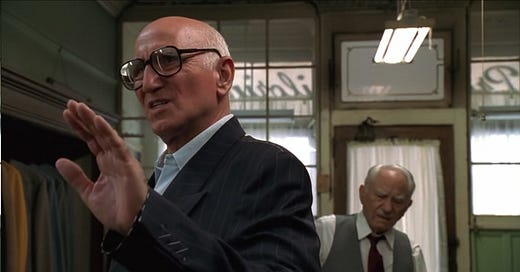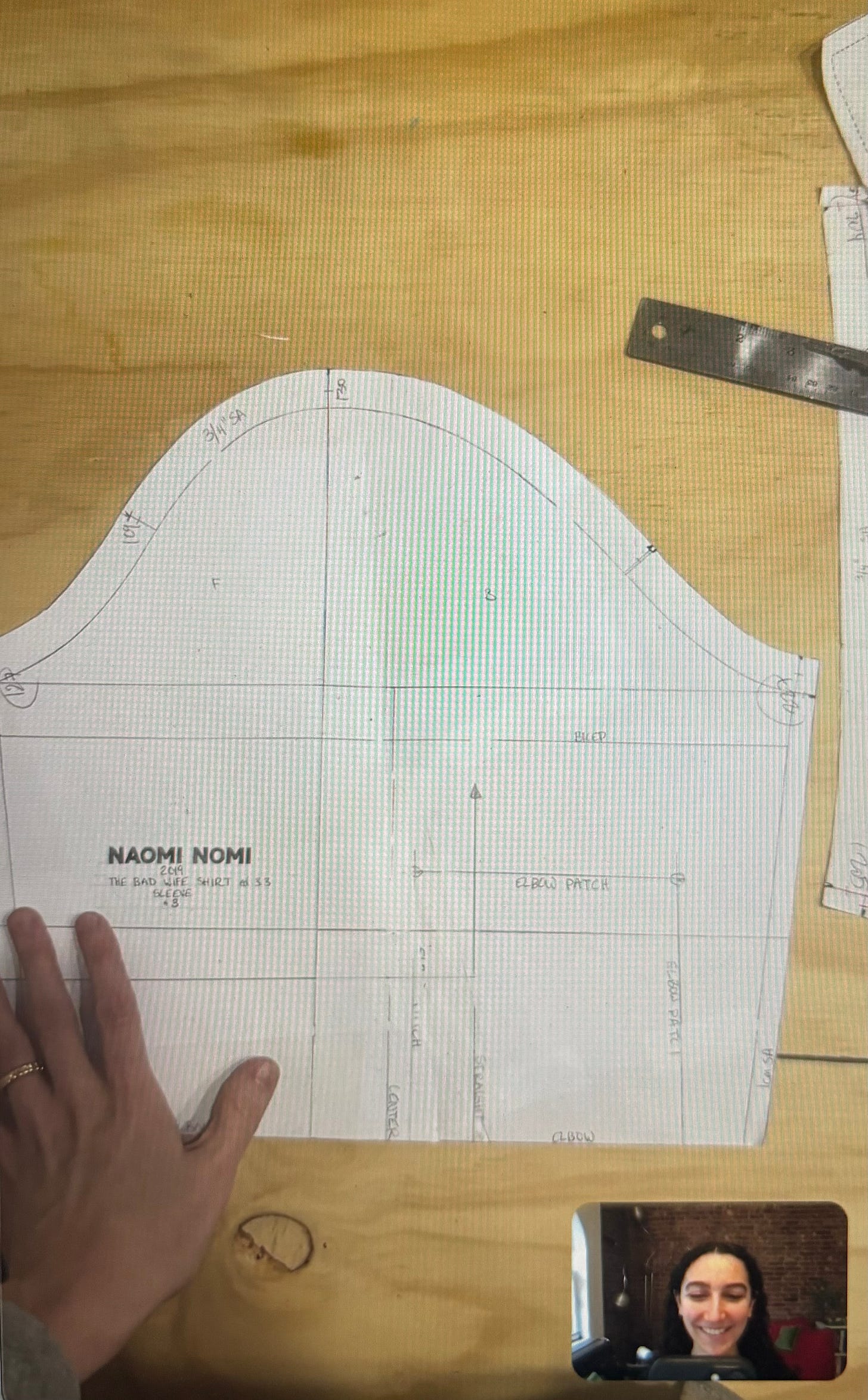This post is part of Repair Month, a series dedicated to taking better care of the stuff we already own instead of buying more of it. Join the discussion thread, here.
Going to the tailor can feel like a chore. Whenever it’s on my to-do list, I often focus more on the physical act of getting there than what I’ll say when I arrive. This means that when the tailor inevitably asks, “So, where do you want your hem to fall?” I usually reply with a shrug. Aren’t they supposed to know?
“Tailors are experts on taking clothes apart and putting them back together,” says Naomi (Nomi) Mishkin, founder and creative director of Naomi Nomi, a made-to-order and small-batch garment brand based in Brooklyn. “You’re the expert on how you like your clothes to fit, and the one who has to advocate for your aesthetic.”
She compares a visit to a tailor to getting a haircut. You wouldn’t show up to a salon and tell a stylist you’ve never met before to just do whatever they think is best, right? You’d go in with an understanding of what suits you, or what you’re interested in trying, and maybe come equipped with a few reference images. It should be a conversation. “You don’t need to know the exact words, but you should have a sense of what you want it to look like,” Nomi adds.
Even when you know exactly what you want, though, it can be hard to advocate for yourself. You’re probably stripping down in a small, makeshift dressing room. The tailor is probably a man who is much older than you, who grunts more than he speaks. You also might not feel like you know what you’re talking about. But you do! You know your body and your taste. Below is a cheat sheet to help you navigate the rest.
What to bring:
The garment you want to be tailored, obviously.
NOTE: “If I’m going to a tailor for the first time, I might not bring them the piece I want chopped in half,” says Nomi. “Maybe experiment with a hem first.”
An idea of how you want the piece to look and feel on your body. Consult reference images and a mirror.
If you’re getting pants hemmed, the shoes you want to wear with them.
Self-confidence and a willingness to be touched a bit.
What you can’t ask for:
According to Nomi: “There are certain things that are just not worth it and kind of impossible to change. Those two things are armholes and crotch seams.”
Nomi is known for her wonderful shirts, and she pulled out a pattern for one over FaceTime to help explain.
Straight lines are easy to adjust. But curves? Oof. Clothes are put together like a puzzle, and if you adjust the round side of one piece, like armholes and crotch seams, it’s not going to fit with the rest. It will probably require a full reconstruction job, and at that point, you might as well just invest in a different garment.
“If I’m shopping, and it doesn’t fit in the arms, shoulders, or crotch, it’s not coming home with me,” Nomi says.
The best you can do is ask the tailor to see how much “seam allowance” there is. Like a piece of looseleaf, every seam has a margin, but sometimes there’s only a very small bit to work with, like 3/4 of an inch.
What you can ask for:
Pretty much everything else.
“There are no rules,” says Nomi. “This an art, not a science!”
When I’m shopping, if I see a piece I’ve been searching for for years, but it’s maybe a size or two in the wrong direction, I’ll consider getting it tailored to fit. (If the price is right.) I once had a green Prada skirt taken three sizes down, for example, because I already had the matching blazer. Worth it!
So you want something made-to-measure…
A few weeks ago, I called Emilie Rose Hawtin, founder of Clementina. (Emilie also happens to be one of the people I interviewed for my NYTimes story about the name Emily.) Emilie is a menswear whisperer. She works with some of the best ateliers and brands around the world — an atelier is where bespoke tailors will make you a made-to-measure piece — on capsule collections of suits, shirts, opera shoes, etc., designed specifically for women.
SIDEBAR: Made-to-measure means the atelier designed a silhouette already that you can have made to your measurements, in a fabric you choose, and adjust the details. Bespoke is when they start from scratch.
“Most men's ateliers will make women’s pieces very well, but they need guidance,” Emilie explains. She acts as something of a translator. “They don't inherently understand our bodies or concerns. You can tell them you don't want to think about your butt or your chest, or that you want to make sure you can fit sweaters without any bulk. Don't be shy; they've seen it all.”
Below are her tips for building something special with an expert:
“You're in charge here. Bring jackets, trousers or suits that you love to wear and show them. Tell them why. Is it the fabric? The fit?”
“Ask them for examples of their pieces and point to things you like. Tell them why.”
“Fabric is everything. Go through the books together. If something is almost right but not totally right, tell them, and they can find more options. Make sure it's lightweight, great quality, and not a kooky blend. If you choose wool, a silk blend feels elegant and lasts. Wool can be worn in the summer; some are so lightweight you won’t even notice. For linen, make sure it's heavier to avoid crinkling. And experiment with colored linen. Brown is year-round and wildly chic with bright colors.”
“Trust your instincts. If a fabric feels slightly heavy to you, it probably will when you're wearing it. Do you generally wear looser, slinkier fabrics? Do you love linen? Think about that before going in, and communicate it.”
“Wide collars and wide lapels are extremely flattering on all women. The small collars on most women’s shirts do us few favors and aren't empowering to wear. That's where men's shirts come in. Most come in small sizes, especially Drake's dress shirts (their knits, especially with a shawl collar, are great on women too).”
“Stick to flap pockets on a suit jacket, unless you're going for a country/sporty look. (Sporty pockets = patch pockets, these look like they're "patched" outside of your jacket.) Flap pockets are elegant and double as a handbag; you can fill them with a ton of stuff and they won't add bulk. Since many men opt for patch pockets, tailors will suggest them — don't take the bait!”
Or maybe you want to start a little smaller…
Of course, having a garment made requires patience, effort, and money. Made-to-measure pieces are usually a 6-12 week process, while bespoke can take a year. But if you look at luxury designer prices today, you’ll likely save money having garments made. The fabric and construction will be lasting, you’ll wear it more because it’s made to fit only you, and your tailor will help you maintain it over time. If you want to start off by messing around with some ready-to-wear, though, here are Emilie’s tips:
“Ralph Lauren Purple Label on eBay will give you lasting classics that you can bring to your local dry cleaner to fit,” she says. “I buy Charvet men's shirts and tuxedo shirts in smaller sizes on eBay all the time. Tons of incredible bespoke pieces, and shoes, can be found there for a tiny fraction of the cost. Just know your measurements.”
Good luck! And have some fun. You got this.
NEXT TIME: THE THING YOU’VE ALL BEEN WAITING FOR: THE REPAIR MONTH GOOGLE DOC. If you have submissions for your favorite tailor, cobbler, jewelry repair person, etc., please add them to this thread with a little note about why you trust them with your [Gollum voice] precious. You can also email me!






